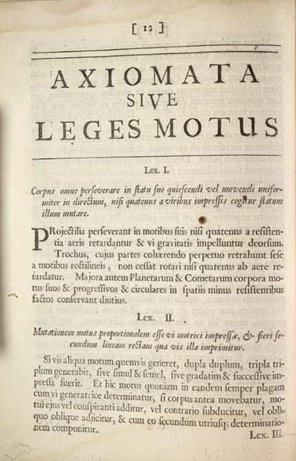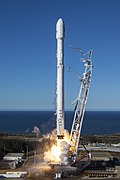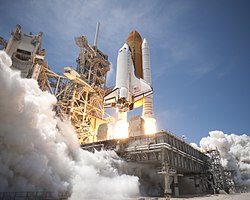Newton's laws of motion
Isaac Newton (1642–1727) is widely known as the father of dynamics, the study of motion. He developed three laws that are the foundation of classical mechanics. They are believed to be true because the results of experiments by scientists agree with this.
First law (sometimes called inertia)
- If a body is at rest it remains at rest or, if it is in motion, it moves with uniform velocity, until it is acted on by a net force.[1] Alternatively, everybody in this universe will be in a state of rest or uniform motion unless acted upon by an external force or otherwise.
From the above statement, it's clearly observable that Newton's first law defines force and inertia.
This law also gives the Qualitative definition of force.
A uniform velocity means that an object moves at a constant speed without changing direction (i.e. in a straight line). A net force means that the forces acting on the object are not balanced. In other words, the first law states two things:
- A stationary object will only begin to move if there is an unbalanced force acting on it.
- A moving object will only change speed or direction if there is an unbalanced force acting on it.
The first part states that a table resting on the ground will not move unless pushed. Although gravity is acting on the table, pulling it down, there is a reaction force from the ground which is pushing it back. The forces acting on the table are balanced, so the object will not move.
The second part is harder to explain. A ball rolling along a flat surface will slow down and eventually come to a halt. This is because of friction, which is a force that slows the ball down. A ball rolling down a slope is also affected by friction, but the effect of the force of gravity is stronger than the friction, so there is a net force acting in the direction in which the ball is moving. In a place without the forces of friction, air resistance and gravity (e.g. in outer space) a moving object would keep on moving in a straight line if there were no force to slow it down or change its direction.
Second law
- For a particle of mass [math]\displaystyle{ m }[/math], the net force [math]\displaystyle{ F }[/math] on the particle is equal to the mass [math]\displaystyle{ m }[/math] times the particle's acceleration [math]\displaystyle{ a }[/math]:[3]
- [math]\displaystyle{ \mathbf F=m\mathbf a }[/math].
Newton's second law states that acceleration of a particle is dependent on the forces acting upon the particle and the particle's mass. For a given particle, if the net force is increased, the acceleration is increased. It's also stated that the rate of change of momentum of a body is directly proportional to applied force and takes place in the direction in which the force acts.[4] For a given net force, the more mass a particle has, the less acceleration it has.
For example, weight is a force that we feel on Earth, caused by the gravity. The weight [math]\displaystyle{ W }[/math] on a particle is given by
- [math]\displaystyle{ \mathbf W=m\mathbf g }[/math],
where [math]\displaystyle{ m }[/math] is the mass of the particle and [math]\displaystyle{ g }[/math] is the local gravitational acceleration (not to be confused with G, the universal gravitational constant), roughly equal to 9.8 meters per second2 (32 feet per second2) on Earth.
We can express Newton's second law in terms of momentum. The momentum [math]\displaystyle{ p }[/math] of a particle is defined as the product of its mass [math]\displaystyle{ m }[/math] and velocity [math]\displaystyle{ v }[/math]:[5]
- [math]\displaystyle{ \mathbf p=m\mathbf v }[/math].
The acceleration [math]\displaystyle{ a }[/math] of a particle is the time derivative of its velocity [math]\displaystyle{ v }[/math]:
- [math]\displaystyle{ \mathbf a=\frac{\mathrm d\mathbf v}{\mathrm dt} }[/math].
Therefore,
- [math]\displaystyle{ \mathbf F=m\mathbf a=m\frac{\mathrm d\mathbf v}{\mathrm dt}=\frac{\mathrm d(m\mathbf v)}{\mathrm dt}=\frac{\mathrm d\mathbf p}{\mathrm dt} }[/math].
Thus, we have another way of stating Newton's second law:
- For a particle of mass [math]\displaystyle{ m }[/math], the net force [math]\displaystyle{ F }[/math] on the particle is equal to the time derivative of the particle's momentum [math]\displaystyle{ p }[/math]:[3]
- [math]\displaystyle{ \mathbf F=\frac{\mathrm d\mathbf p}{\mathrm dt} }[/math].
In classical mechanics, the two forms of the second law, [math]\displaystyle{ \mathbf F=m\mathbf a }[/math] and [math]\displaystyle{ \mathbf F=\frac{\mathrm d\mathbf p}{\mathrm dt} }[/math], are completely equivalent.[3] Note that we assume that the mass [math]\displaystyle{ m }[/math] of a particle does not change.[3]
Third law
- For every action, there is an equal and opposite reaction. Or every action always reacts in the opposite direction.
This is best understood with billiard balls, where you can easily see the action/reaction pairs of forces. Likewise, when you kick a football, not only does the ball move, but you feel a force on your foot.
The size of the forces on the first object equals the size of the force on the second object. The direction of the force on the first object is opposite to the direction of the force on the second object. Forces always come in pairs - equal and opposite action-reaction force pairs.
A variety of action-reaction force pairs are evident in nature. Consider the propulsion of a fish through the water. A fish uses its fins to push water backwards. But a push on the water will only serve to accelerate the water. Since forces result from mutual interactions, the water must also be pushing the fish forwards, propelling the fish through the water. The size of the force on the water equals the size of the force on the fish; the direction of the force on the water (backwards) is opposite the direction of the force on the fish (forwards). For every action, there is an equal (in size) and opposite (in direction) reaction force. Action-reaction force pairs make it possible for fish to swim.
Consider the motion of a car on the way to school. A car has wheels which spin forwards. As the wheels spin forwards, they grip the road and push the road backwards. Since forces result from mutual interactions, the road must also be pushing the wheels forward. The size of the force on the road equals the size of the force on the wheels (or car); the direction of the force on the road (backwards) is opposite the direction of the force on the wheels (forwards). For every action, there is an equal (in size) and opposite (in direction) reaction. Action-reaction force pairs make it possible for cars to move along a roadway surface.
Proposed additional laws
- Law 0. One candidate for a "zeroth law" is the fact that at any instant, a body reacts to the forces applied to it at that instant.
- Law 4. Similarly, the idea that forces add like vectors (or in other words obey the superposition principle), and the idea that forces change the energy of a body, have both been described as a “fourth law.”
Newton's Laws Of Motion Media
A free body diagram for a block on an inclined plane, illustrating the normal force perpendicular to the plane (N), the downward force of gravity (mg), and a force f along the direction of the plane that could be applied, for example, by friction or a string
Rockets work by creating unbalanced high pressure that pushes the rocket upwards while exhaust gas exits through an open nozzle.
A bouncing ball photographed at 25 frames per second using a stroboscopic flash. In between bounces, the ball's height as a function of time is close to being a parabola, deviating from a parabolic arc because of air resistance, spin, and deformation into a non-spherical shape upon impact.
Two objects in uniform circular motion, orbiting around the barycenter (center of mass of both objects)
An undamped spring–mass system undergoes simple harmonic motion.
Rockets, like the Space Shuttle Atlantis, expel mass during operation. This means that the mass being pushed, the rocket and its remaining onboard fuel supply, is constantly changing.
Related pages
References
- ↑ "Newton's laws of motion | Definition, Examples, & History | Britannica". www.britannica.com. Retrieved 2021-11-19.
- ↑ "Newton's First Law of Motion". www.physicsclassroom.com. Retrieved 2021-11-19.
- ↑ 3.0 3.1 3.2 3.3 Taylor, John R. (2005). Classical Mechanics. University Science Books. pp. 13–14. ISBN 1-891389-22-X.
- ↑ "Newton's Three Laws of Motion". ccrma.stanford.edu. Retrieved 2021-11-19.
- ↑ Ohanian, Hans C. (1985). Physics. Vol. 1 (Second ed.). W. W. Norton & Company. p. 113. ISBN 0-393-95748-9.











